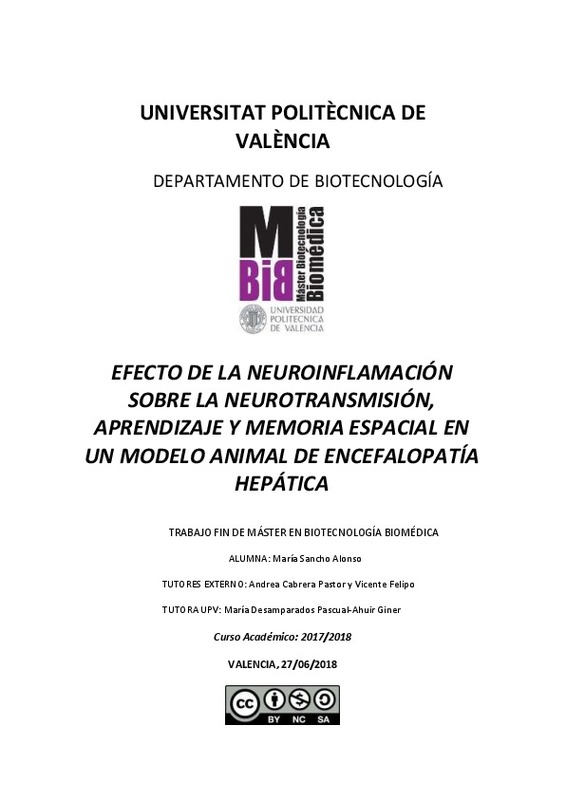JavaScript is disabled for your browser. Some features of this site may not work without it.
Buscar en RiuNet
Listar
Mi cuenta
Estadísticas
Ayuda RiuNet
Admin. UPV
Efecto de la neuroinflamación sobre la neurotransmisión, aprendizaje y memoria espacial en un modelo animal de encefalopatía hepática
Mostrar el registro sencillo del ítem
Ficheros en el ítem
| dc.contributor.advisor | Pascual-Ahuir Giner, María Desamparados
|
es_ES |
| dc.contributor.advisor | Cabrera Pastor, Andrea
|
es_ES |
| dc.contributor.author | Sancho Alonso, María
|
es_ES |
| dc.date.accessioned | 2018-10-23T06:51:37Z | |
| dc.date.available | 2018-10-23T06:51:37Z | |
| dc.date.created | 2018-07-20 | |
| dc.date.issued | 2018-10-23 | es_ES |
| dc.identifier.uri | http://hdl.handle.net/10251/111096 | |
| dc.description.abstract | La encefalopatía hepática (EH) es un síndrome neuropsiquiátrico complejo causado por un fallo hepático. Al no ser el hígado capaz de detoxificar la sangre de forma eficiente, ciertos compuestos se acumulan, pudiendo atravesar algunos la barrera hematoencefálica y causar neuroinflamación. De entre estas sustancias, cabe destacar el amonio. La hiperamonemia y la neuroinflamación actúan de forma sinérgica en inducir las alteraciones en la neurotransmisión glutamatérgica y gabaérgica que causan deterioro cognitivo y motor, llegando en los casos más graves al coma clínico. La interleucina 1 beta (IL-1β) posee propiedades proinflamatorias y sus niveles están aumentados en modelos animales con EH. La IL-1β es el desencadenante de vías de señalización que alteran la expresión en membrana de receptores AMPA y NMDA, alterando así la neurotransmisión y en consecuencia el aprendizaje y la memoria espacial. El objetivo del presente trabajo es analizar el efecto del antagonista del receptor de la IL-1β, IL1Ra, pretendiéndose comprobar si el bloqueo de dicho receptor in vivo revierte las alteraciones causadas por la actuación conjunta de la hiperamonemia y la neuroinflamación, restableciéndose así los patrones de expresión en membrana y por tanto la neurotransmisión. A ratas con hiperamonemia crónica mediante una dieta rica en amonio se les administrará mediante bombetas osmóticas el tratamiento con el antagonista del receptor de IL-1β. Se evaluará si el tratamiento in vivo restaura la memoria y aprendizaje espacial y se estudiará si normaliza la expresión en membrana de receptores ionotrópicos en el modelo animal de EH. | es_ES |
| dc.description.abstract | Hepatic encephalopathy (HE) is a complex neuropsychiatric syndrome caused by liver failure. Since the liver is not able to detoxify efficiently the blood, some compounds, like ammonium, tend to be accumulated, and may cross the blood-brain barrier and cause neuroinflammation. Hyperammonemia and neuroinflammation act synergistically inducing alterations in glutamatergic and gabaergic neurotransmission that cause cognitive and motor impairment, reaching in the most serious cases the clinical coma. Interleukin 1 beta (IL-1β) has proinflammatory properties and it is known that its levels are increased in animal models of HE. IL-1β triggers signalling pathways that alter the membrane expression of AMPA and NMDA receptors, altering the neurotransmission and, consequently, the spatial memory and learning. The main aim of the present study is to analyse the effect of the IL-1β receptor antagonist, IL1Ra, in order to determinate whether the block of this receptor in vivo reverts the alterations caused by hyperammonemia and neuroinflammation, restoring the membrane expression patterns and, consequently, the neurotransmission. Rats will be fed with an ammonium containing diet and IL-1β receptor antagonist will be administered through mini osmotic pumps. We will evaluate whether the treatment restores spatial learning and memory and whether the ionotropic membrane receptors expression are normalised. | es_ES |
| dc.language | Español | es_ES |
| dc.publisher | Universitat Politècnica de València | es_ES |
| dc.rights | Reconocimiento - No comercial - Compartir igual (by-nc-sa) | es_ES |
| dc.subject | Encefalopatía hepática | es_ES |
| dc.subject | aprendizaje y memoria espacial | es_ES |
| dc.subject | hiperamonemia | es_ES |
| dc.subject | neuroinflamación | es_ES |
| dc.subject | NMDA | es_ES |
| dc.subject | AMPA e IL1β | es_ES |
| dc.subject | Hepatic encephalopathy | es_ES |
| dc.subject | learning and spatial memory | es_ES |
| dc.subject | hyperammonemia | es_ES |
| dc.subject | neuroinflammation | es_ES |
| dc.subject | AMPA and IL-1β | es_ES |
| dc.subject.classification | BIOQUIMICA Y BIOLOGIA MOLECULAR | es_ES |
| dc.subject.other | Máster Universitario en Biotecnología Biomédica-Màster Universitari en Biotecnologia Biomèdica | es_ES |
| dc.title | Efecto de la neuroinflamación sobre la neurotransmisión, aprendizaje y memoria espacial en un modelo animal de encefalopatía hepática | es_ES |
| dc.type | Tesis de máster | es_ES |
| dc.rights.accessRights | Abierto | es_ES |
| dc.contributor.affiliation | Universitat Politècnica de València. Departamento de Biotecnología - Departament de Biotecnologia | es_ES |
| dc.description.bibliographicCitation | Sancho Alonso, M. (2018). Efecto de la neuroinflamación sobre la neurotransmisión, aprendizaje y memoria espacial en un modelo animal de encefalopatía hepática. http://hdl.handle.net/10251/111096 | es_ES |
| dc.description.accrualMethod | TFGM | es_ES |
| dc.relation.pasarela | TFGM\78304 | es_ES |






